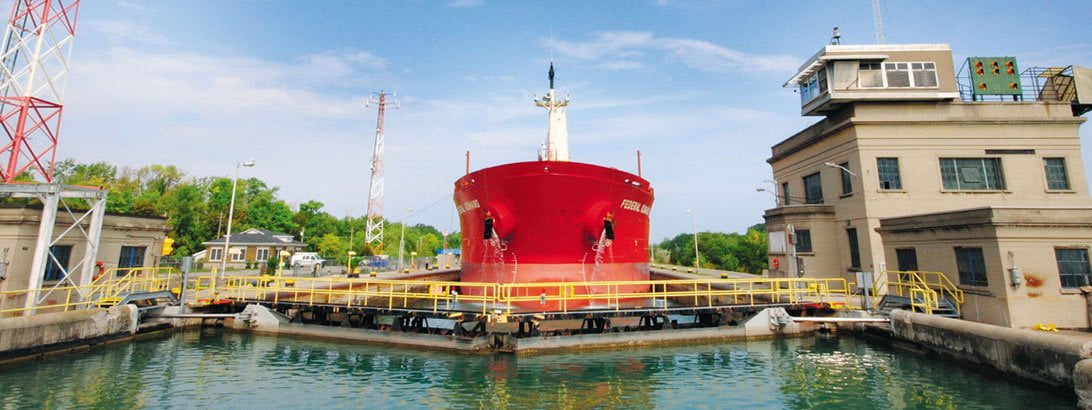In this edition:
- St. Catharines studies feasibility of new Hwy. 406 crossing
- Siscoe says 35 years not enough time for taxpayers to clear water infrastructure backlog
- Retail sales fall in January, led by motor vehicles and parts
- Class of 2020 faced employment challenges, but are employed at same rate as peers three years on
- GNCC, Meridian host webinar on Business Accelerator Loan
- Select drivers get free rush-hour access to Highway 407 ETR
- Transport Canada announces updated agreement with St. Lawrence Seaway Management Corporation
- Province will not introduce legislation that automatically approves fourplexes: Ford
- Focus on Health & Safety

St. Catharines studies feasibility of new Hwy. 406 crossing
St. Catharines is looking at the feasibility of building a pedestrian and cyclist bridge over Highway 406 to create an east-west connection between Merritton and Glenridge.
The highway divides the two areas of the city with no crossings for about a 2.5-kilometre stretch between Westchester Crescent downtown and Chestnut Street West to the south by The Pen Centre.
The city announced Thursday it has received a $50,000 grant from Infrastructure Canada’s Active Transportation Fund that will pay for the entire study.
St. Catharines staff have been asked to come up with a new long-term water and wastewater infrastructure plan for taxpayers that’s more sprinkle, less downpour.
Mayor Mat Siscoe asked for alternative options this week after staff presented a 10-year water and wastewater financial plan that recommended catching up on the related infrastructure backlog over a 35-year-period.
The proposed plan would see rates climb on the average annual bill from about $1,130 in 2024 to more than $2,660 by 2034.

Retail sales fall in January, led by motor vehicles and parts
Retail sales decreased 0.3% to $67.0 billion in January. Sales were down in three of nine subsectors and were led by decreases in motor vehicle and parts dealers (-2.4%), which recorded their first decline in five months.
Core retail sales increased 0.4% in January, posting its second consecutive monthly increase. The gain was led by higher sales at sporting goods, hobby, musical instrument, book, and miscellaneous retailers (+3.0%).

The postsecondary graduating class of 2020 faced unique challenges as it entered the labour market during the initial waves of the COVID-19 pandemic. Results from the National Graduates Survey reveal that over half (55.6%) of those who graduated in 2020 saw their employment status or employment plans change at some point that year as a result of the pandemic.
Despite the labour market challenges faced by the class of 2020, their employment rate three years after graduation (90.3%) was similar to that of 2015 graduates (89.9%). The 2023 employment rate for 2020 graduates was slightly higher than the 2023 employment rate for the overall Canadian core working age population (aged 25 to 54 years) with a postsecondary certificate or diploma (87.3%).

GNCC, Meridian host webinar on Business Accelerator Loan
Discover how an Accelerator Loan can energize your business! Securing business financing can be difficult for entrepreneurs, and unfortunately this challenge is often greater for entrepreneurs in diverse groups, including: Indigenous peoples, women entrepreneurs, newcomers to Canada, visible minorities, 2SLGBTQ+ people, and people with disabilities.
To help close that financing gap, Meridian’s Business Accelerator loans offer flexible term financing for improved access to working capital, supported by BDC.
Click here to watch the webinar.

Select drivers get free rush-hour access to Highway 407 ETR
A select number of customers are getting free rush-hour access to Highway 407 ETR between April and June of this year.
“This promotion was offered to a small number of customers,” said 407 ETR spokesperson Jeff Dean via email.
“To be eligible for 407 ETR pricing promotions, you must be a customer of 407 ETR and have an active My Account with your current email address.”
Transport Canada announces updated agreement with St. Lawrence Seaway Management Corporation
The St. Lawrence Seaway is a trade corridor for key bulk commodities used across Canada and the United States. The Government of Canada says they are committed to supporting this binational waterway’s long-term economic growth and sustainability and reinforcing Canada’s reputation as a reliable and strong trading partner.
The Minister of Transport, Pablo Rodriguez, and Terence Bowles, President and CEO of the St. Lawrence Seaway Management Corporation, announced that they signed an agreement for the Corporation — a not-for-profit organization — to continue managing, maintaining, and operating the Seaway, which it has done since 1998.
Province will not introduce legislation that automatically approves fourplexes: Ford
Ontario will not introduce legislation to automatically allow fourplex homes to be built across the province, Premier Doug Ford said Thursday.
Such legislation – which would override municipal prohibitions – would be a “massive mistake,” Ford said.
“It’s off the table for us,” Ford said. “We’re going to build homes, single dwelling homes, townhomes, that’s what we’re focused on.”
Ford has pledged to build 1.5 million homes by 2031.
Did you know?
A sheet of graphene can be one atom thick, 1.3 millionths the thickness of a sheet of paper.
Focus on Health & Safety
Driving along Richmond Street in downtown Toronto the other day, two men were out on the street acting as flag people to allow a concrete mixer to safely exit a high-rise construction site.
It was a cold day and both men had their hard hats precariously balanced atop toques and the pulled-up hoods of their sweatshirts.
Those hard hats were unlikely to provide much protection if something were to fall on their heads. Hats that don’t fit tightly enough — so they’re harder to put on and off than a baseball cap — won’t provide protection if they just come off on impact or if a worker falls, said Remi Badra, product manager of head protection at manufacturer PIP Canada.
Anything worn under a hard hat should also be approved by the manufacturer, said Badra, and needs to be relatively thin and tight.
More Canadians have poor mental health. The economy is partly to blame, survey says
The double whammy of the COVID-19 pandemic and economic stressors is taking a toll on the mental health of Canadian adults, according to new data released by the Canadian Institute for Health Information on Thursday.
An international survey conducted in 10 high-income countries by The Commonwealth Fund found that 29 per cent of Canadians aged 18 and older suffered from depression, anxiety or another mental health issue in 2023.
At the same time, many Canadians weren’t seeking mental health care because of the cost, the study said.
Fewer Canadian adults — 20 per cent — reported having mental health problems back in 2016.
Through the Daily Updates, the GNCC aims to deliver important business news in a timely manner. We disseminate all news and information we feel will be important to businesses. Inclusion in the Daily Update is not an endorsement by the GNCC.






